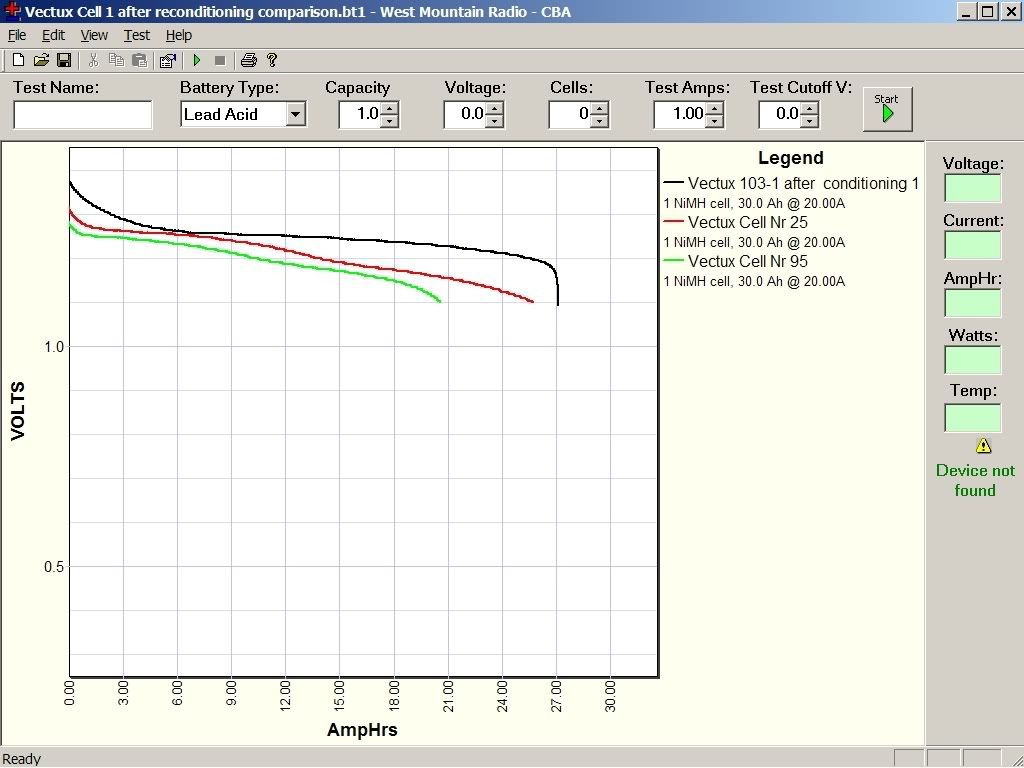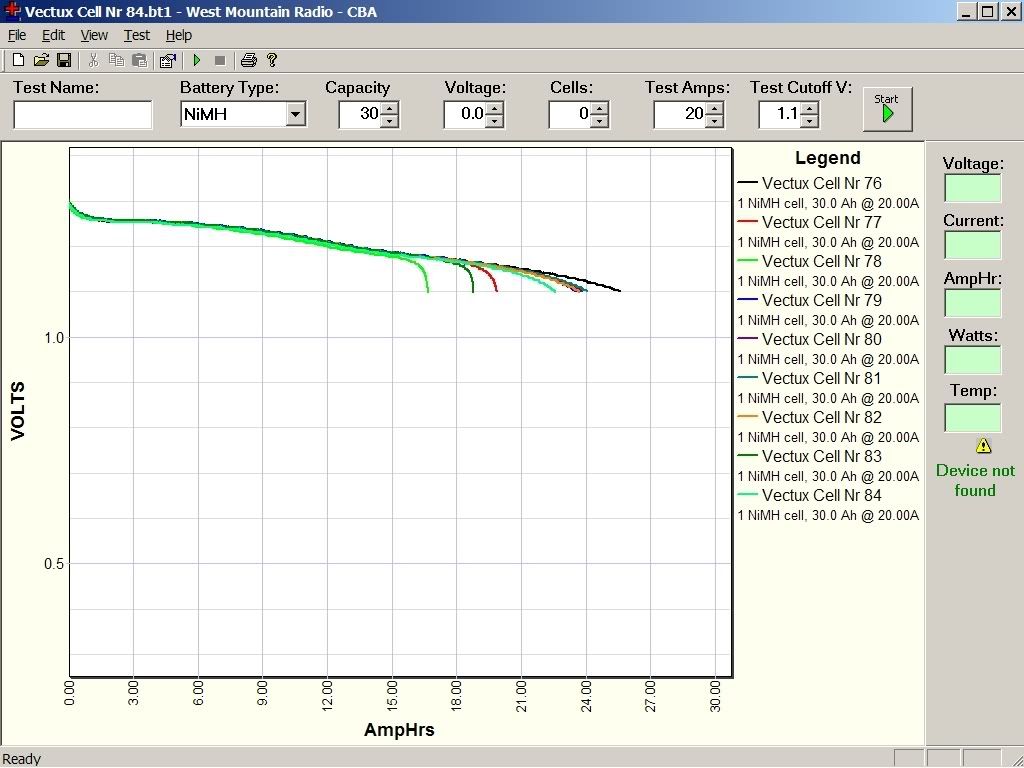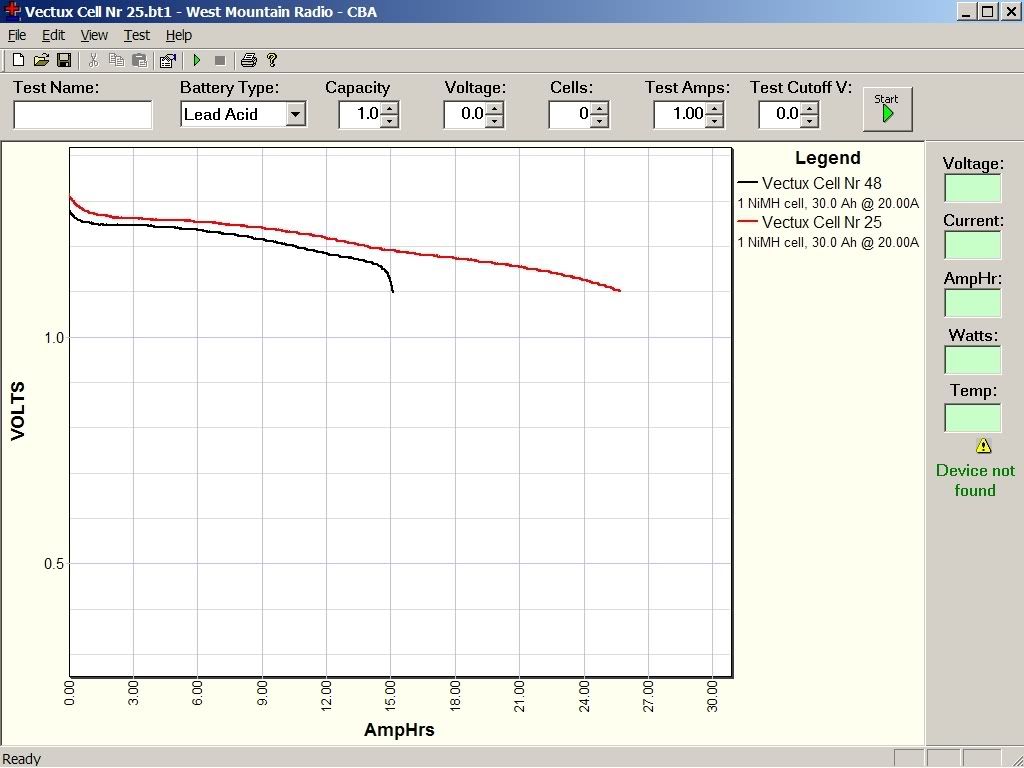Good evening or good day to all,
My bike is a 2007 with 12,000 KM and Oct 2008 software. Apart from the usual glitches at the beginning like motor controller board, batteries and charger the bike has been just great. (repaired under guarantee before Vectrix went belly up) Most of the time i would only need the first half of the battery concerning range and continually top it up. This has generally worked well. Some days ago with around 6 or 7 bars left I got the red battery light come on and then as we all know quite abruptly the bars drop to zero. This was a range of 35 km or so. I charged up from this point but the batteries started to get quite hot - over 35 degrees - so I stopped the charge as I did not want to put so much heat into the batteries.
I trolled through a lot of the earlier posts of Mik's and others issues, and wanted to reinterate my own experiences. It seems to me that the software knows exactly how much charge to put into the batteries from when the red light comes on. (ie empty batteries) BUT the point is - the batteries may NOT be fully empty. So the charger trys to ram all this extra charge into the batteries that are already nearly full - even though the battery gauge does not reveil this.
So I figured to completely discharge the battery - not only til the red battery light comes on but until you get the message BalSult or something similar displaying near the range gauge. This is the low reset point of the battery. I then recharged again + the software decided that the batteries needed an equalisation. The batteries got to about 33 degrees but no more.
I did another discharge where the range was not fantastic - about 50 km. Again I waited until I got the low battery reset message again and then recharged. Battery temp did not go above 31 degrees despite an ambient of 25.
Today I did another discharge. The difference was that I travelled 72 KM before I got to the reset point. I was traveling in a very hilly area (South of France) speeds between 40 and 70 km/hour. I did try and take it easy though. The most important point is that every bar on the battery gauge was fully useable - some of the last bars lasted as long as the first 2 normally do! When the red light finally came on with 1 bar left I checked the voltage and it was 122 volts. I continued on until I got the Bat reset again.
I have just given the bike a 2 hour cool down and now it is charging again. It is 3/4 complete and the temperature is 28 degrees with an ambient of 25 outside.
I know from lots of previous posts that it is not good to discharge NiHY batteries this low. All I know is that my range is, in fact, even better than it has been since the bike was new. I plan now to run normally and not do successive discharges for a while and see how the range holds up. I think it is very important not to let the batteries get too hot.
Overall I have been very happy with the machine and can wholly recommend it to anybody. In fact one of my best friends has now said that he wants to buy one.
What more can you want?
Thanks for listening and I hope this post can be useful.
Jonathan



HAHA! No wonder they went bust, if nearly all the main parts of the power train failed!
But besides of that, what you are describing is (I think) the effect of exercise cycling of a NiMH battery. They suffer voltage depression if repeatedly discharged partially (and then recharged). Once they suffer significant voltage depression, they can not produce the required current without too much voltage drop. The electronics interpret this as an empty battery and throw up the warning light; but the battery is not really empty at that point. The remaining charge needs to be removed by slow discharge, either very gentle driving (not safe in my opinion) or some other method. The extended running of the impellers has been discussed as an option for this in an earlier thread.
If you do not usually need the full range, then you could also keep the battery at a lower SOC. This, IMHO, will prolong it's life and will increase the usefulness of the bike. But it takes a little more effort.
I noticed that the cells in my Vectux remain balanced despite their bad capacity differences (worst cells have around 50% capacity of best cells and increased self-discharge rate) when I only use timed charging and stay away from fully charged.
I also leave the Vectux standing partially discharged whenever this is convenient. At work, I plug it in immediately upon arrival in the morning and charge it to 2/17th less than what would be full for my battery. This is so that it is ready for use immediately in case I need to leave work early and have no other transport available. At home, I only run the ABCool timed for a few hours to cool and equalise the battery cell temperatures, then I leave it parked uncharged until about 1hr before I need it next. That can be several days away.
The effect of this seems to be that the "self-discharge ratio" between good and poor cells is reduced, maybe even completely removed.
As Antiscab pointed out in another post: Self-discharge rate is dependent on temperature and SOC (State-of-Charge). If the cells are full, they loose more to self-discharge. When they self-discharge, they also produce more heat. During the last stage of charging, the cells heat up.
With my 20km commute, I can stay 2-3/17th away from empty and 2-3/17 away from full all the time, despite of the damaged battery (It has now gone about 7000km since I halted the cell destruction by installing the M-BMS!)
The beauty of keeping the battery at a low SOC as described above is this: The heat generating and aging last part of the charge process is eliminated most of the time - that should increase cycle life significantly. And, the full range is available when you occasionally need it - because you can always decide to fully charge before a long ride, without voltage depression biting you in the rear end when you need the range the most!
About the effect that you now have better range than at the start: This is due to the break in effect. If a NiMH battery is well looked after, then it's usable capacity actually increases for quite some time before peaking.
Have a look at this very interesting document about Burp charging: INVESTIGATION OF THE RESPONSE OF NIMH CELLS TO BURP CHARGING http://corsair.flugmodellbau.de/files/elektron/NASA-II.PDF
Particularly Fig. 3 is relevant to this.
This information may be used entirely at your own risk.
There is always a way if there is no other way!
Hello from Maryland, USA! On Wednesday, 25 August 2010, I took my Vectrix to the FACTORY for previously arranged/scheduled service! The Vectrix factory is now located in southeastern Massachusetts, about 450 miles from me. Upon arrival, I was warmly greeted, and ushered into the service area, near the main assembly line. The Vectrix engineers quickly evaluated my vehicle, and determined that my battery had some defective cells, so it was replaced, and all other servicing, including installing a new, 200 amp main fuse, new seat, and updating the software, was complete (under warranty) in about 2 hours. During my visit, I was given a tour of the facility, and saw numerous 3 wheel versions, and the new lead-acid, lower cost, smaller,direct hub motor driven, modified Chinese 35 mile per hour scooter, as well as the LITHIUM BATTERY for future Vectrix VX-1 type scooters! Yes, I actually SAW and TOUCHED this LITHIUM Vectrix battery, which uses specially manufactured Li-FePo4 cells. These cells, in metal cases, are made by GOLDPEAK, and are physically sized especially for the Vectrix battery bay, each cell is similar in shape to the nickel-metal hydride cells, but much LONGER. They are installed in a SINGLE layer, but in 2 boxes, same as the present cells, and include battery management for each cell. A newer, much less expensive charger is also available now, so having to replace a charger will not be such a financial shock.
After returning home, I topped off the new battery, and took the bike for a test ride, to Washington, D.C. traveling up and down some fairly good hills, for the 19 mile round trip. Normally, near the end of this trip, power would become restricted, and battery bars would be rapidly dissappearing, but this time, 7 bars remained, so I opened the throttle for a "Speed Test", and reaced an indicated 70 miles per hour! The accelleration is also much better now, so I can see why the Washington, D.C. Police have purchased SIXTY of these bikes for patrol useage!Plans are to make the LITHIUM battery available first in NEW bikes, with retrofits available at a later date. So I say YES, Vectrix is ALIVE, but still needs to develop a much better local service ability for their customers.--Robert Curry
Robert M. Curry
Hi there.
This is a picture of superbe voltage depression. Please note, the voltage (1,2v) is not exactly the voltage of the cell because of a
rather weak connection during the measurement. so i lost some "0,1v" in the connection between the cell and the CBA. You see
twodifferent cells. On quite healthy, the other on from a pack with one destroyed cell (melting parts of the black cell box and the
two spacers between the cells)!
My bike suffered maybe some depression to see Mon, 07/19/2010 - 02:01 as I was able to reach home with rather low voltage(122 v)
but no high temperature. As my trips usually are between 20 and 30 km I try to drive distances to 50 or 60 km watching temp and
voltage now and then to eleminate those voltage drop points. But I try to avoid the red battery and high temperatures, so I charge
the bike full after long trips when the voltage drops to 125/126 Volt
Greetings Mike
All the good cells in the Vectux battery showed the voltage depression phenomenon when I first tested them. I did not understand it at the time.
Green = An average cell before reconditioning

Red = The very best cell before reconditioning
Black = An average cell after reconditioning
Here is another overlay that shows very nicely how all the cells in a module with both good and bad cells have the voltage depression dip in the middle of the curve. It occurs at the range limit which I had learned is the maximum before a Balpor would occur - so I had done multiple rides just to about that point, then recharged.

This information may be used entirely at your own risk.
There is always a way if there is no other way!
Mik,
Thanks for posting such useful information in every answer you write.
I have a "silly" question for you: If the weakest cell (n.84 I think) of the pack can give you around 16 Ah, then the useful capacity of the all pack is only 16Ah? About 50% of the original capacity?
That's right. But there was an even weaker cell in the Vectux pack, Nr 103-48. I just showed the overlay of Module 3 (bottom rear on right side) because it had a wide spread of capacities. Some really bad and some really good cells - and they all have the same dip around 15Ah!
Here is an overlay showing the best cell 103-25 and the worst cell 103-48 together:

There are a few technicalities WRT capacity measurement: For example, the capacity should be measured at C/10 ( = 3A ), and I measured at 20A.
I also did not charge the cells very aggressively before the test. It was my first venture into battery analysis and reconditioning, and I was babying them too much! I did not understand how tough they are.
What this graph shows is (again) how the best cell has a dip in the discharge curve at around 15Ah. At that point, the 13 weak cells started to go to their knees, just before the occurrence of a BALPOR. And the good cells never got discharged further than that.
Because the good cells did not get discharged further than the 15Ah mark, that part of their charge developed "Voltage depression".
These cells could still deliver the 20A in this test, but at a SOC below the 15Ah mark they could only deliver it at a lower voltage.
Reconditioning enabled them to deliver much more power again, as shown in my previous post.
In summary: The best cells might have had 30Ah capacity (@3A to 0.9V); and the worst cells had about 60% of the capacity of the best cells.
And, by means of the M-BMS and diligent monitoring, I did limit the range to what the weakest cell could provide. That's how I got another 7000km out of the pack, still counting, with no obvious further deterioration.
Without the M-BMS, the range would not have been limited by just the weakest cells SOC. Instead, the weakest cell would have been reverse charged often and would have failed completely and very soon, followed closely by the other weak cells.
So you are right, R: the (longer term) useful capacity of the pack is limited by capacity of the weakest cell.... But in an unmodified VX-1, the BMS cannot see the weakest cell - and does not limit the range accordingly.
The lesson: Once you have weak cells in your pack, you must stay well clear of the empty point - because the reverse charging of the weakest cells will go undetected and destroy them.
This information may be used entirely at your own risk.
There is always a way if there is no other way!
Nice lesson. Some days ago I have tried to mark a safe level in order to stay well clear of this empty point. I checked at what display level the temps starts to increase abnormally. I marked one bar above that level (11/17). It worked fine. But I discovered that if I ever discharge further below this level, the temperature near a sensor/s increases to 50ºC, voltage drops immediately, range is reduced to 2-3 km... my useful range is 6 bars... The safe level should have stabilized the battery, but in fact it is getting worse...
As the bike is still under warranty (1 year left), I can't do any hardware modifications to save the battery...
This 6 bar range makes my vectrix operational in my Barcelona's daily commute, but I can't ride it into open roads any more.
That's amazing. Thanks for sharing with us this interesting visit to the VUSA's factory. Did you ask about the capacity of these cells? Do they told you a date about the release of these lithium kits?